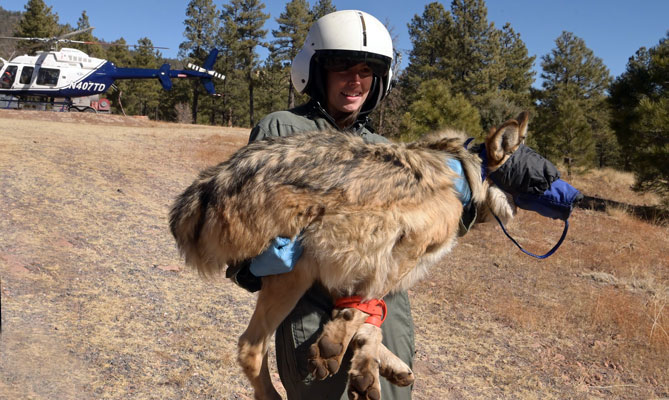The 2024 population survey revealed a minimum of 286 Mexican wolves distributed across Arizona and New Mexico
Contributed Article/Courtesy Arizona Game and Fish Department and New Mexico Department of Game and Fish
PHOENIX — The wild population of Mexican wolves saw another year of growth in 2024, according to the annual census results.
The 2024 population survey revealed a minimum of 286 Mexican wolves distributed across Arizona and New Mexico. This increase marks the ninth consecutive year of population growth, the longest continuous streak since recovery efforts began.
The 2024 minimum count represents an 11% increase from the minimum of 257 wolves counted in 2023. Survey results show the population is distributed with a minimum of 162 wolves in New Mexico and 124 in Arizona.
“Once again, the data collected on the recovering Mexican wolf population show progress, particularly in the context that in 1998 when the first release into the wild occurred, and we now approach the population goals in the current recovery plan,” said Stewart Liley, the Chief of Wildlife for the New Mexico Department of Game and Fish.
“Each year, the wild Mexican wolf population numbers increase, and the areas they occupy expand. Genetic management using pups from captivity is also showing results. In total, 126 pups carefully selected for their genetic value have been placed in 48 wild dens throughout the recovery area since 2016, and some of these fosters have produced litters of their own. As we evaluate Mexican wolf recovery efforts, examining the last decade of data certainly provides confidence that recovery will be achieved.”
The Interagency Field Team gathers Mexican wolf population information from November through February. During this time, the field team conducts ground and aerial counts using various methods, including remote cameras, scat collection, and visual observation. Counting the population at the same time each winter allows for comparable year-to-year trends at a time of year when the Mexican wolf population is most stable.

Among the 2024 findings:
- At the end of 2024, at least 60 packs were documented: 37 in New Mexico and 23 in Arizona. A wolf pack is defined as two or more wolves that maintain an established home range.
- A minimum of 164 pups were born in 2024, 79 of which survived until the end of the year (a 48% survival rate).
- At least 26 breeding pairs (16 in New Mexico and 10 in Arizona) were recorded in 2024.
- At the end of the year, 112 collared wolves were in the wild, which is 39 percent of the minimum population of Mexican wolves.
The field team documented additional success with fostering efforts in 2024. To date, a minimum of 20 fostered Mexican wolf pups have survived to breeding age, and at least 10 fostered wolves have successfully bred and produced litters in the wild. Fostered Mexican wolves have produced more than 20 litters, and several of those offspring have gone on to produce pups of their own.

“The results of this year’s count reflect the hard work of many people and agencies that lead recovery. It also supports the recovery strategies in the 2022 Mexican Wolf Recovery Plan as we see both demographic and genetic objectives being exceeded this year,” said Clay Crowder, Assistant Director, Arizona Game and Fish Department.
“Prior to the first release into the wild, many thought that a successful free-ranging wild Mexican wolf population was impossible, but as we can see from the ninth consecutive year of population growth, we are knocking on the door of recovery.”
The Mexican wolf is listed separately from the gray wolf as an endangered subspecies under the federal Endangered Species Act. In 1977, the partners in Mexican wolf conservation initiated efforts to conserve the subspecies by developing a bi-national captive breeding program stemming from just seven Mexican wolves. Mexican wolves were first reintroduced to the wild in 1998.
In addition to the minimum wild population, approximately 350 Mexican wolves are currently maintained in more than 60 facilities throughout the United States and Mexico under the Mexican Wolf Saving Animals From Extinction program.
Partners in Mexican wolf recovery in the United States include the Arizona Game and Fish Department, New Mexico Department of Game and Fish, U.S. Fish and Wildlife Service, U.S. Department of Agriculture (USDA) Forest Service, USDA APHIS Wildlife Services, White Mountain Apache Tribe, Bureau of Land Management, National Park Service, and the Saving Animals From Extinction program.








